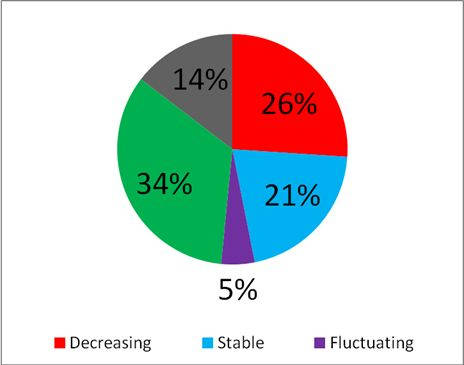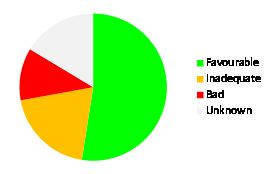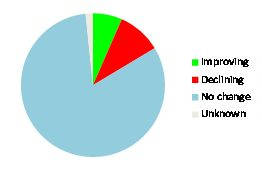- Details on the status of Ireland's birds taken from Ireland's report submitted to the European Commission in accordance with the EUBirds Directive. It can be viewed here:
https://circabc.europa.eu/sd/a/a211d525-ff4d-44f5-a360-e82c6b4d3367/IE_A12NatSum_20141031.pdf
(More comprehensive information is contained in the recently published Bird Atlas of Britain and Ireland, a collaborative work involving state agencies and voluntary bodies across all 5 jurisdictions on these islands.)
- Ireland's first Prioritised Action Framework which targets actions for nature conservation under the EU Habitats and Birds Directives to respond to the issues addressed in the first two reports. It can be viewed here: http://www.npws.ie/publications/PAF/
Further Details :
The Prioritised Action Framework
The Habitats Directive provides for the co-financing by the EU of management costs for habitats and species listed as priorities in the Directive. It foresaw a "Prioritised Action Framework" (or PAF) being adopted by the Commission, having regard to available sources of funding. These sources of funding are in effect the existing EU funding instruments: the European Agriculture and Rural Development Fund, the European Maritime and Fisheries Fund, the Structural and Cohesion Funds and also the LIFE+ fund.
The aim of each country's Prioritised Action Framework is to identify the key issues that need to be addressed in the Natura 2000 network (i.e. the SACs for habitats and SPAs for birds) in the new funding period (2014-20) and clarify which EU fund might provide support for the relevant Natura 2000 measure at a national level. The drive for Prioritised Action Frameworks at this time arose from the Commission's view that there was a clear disparity across the EU between management costs foreseen for the Natura 2000 network, and the earmarking of European funds for that purpose. It therefore sought a more structured approach by Member States in setting out their priorities for work.
The priorities set out in Ireland's Framework document were those habitats and species deemed to be in bad status. The Department engaged in consultation with a wide range of Departments and Government Agencies in drawing up the Framework, and its prioritisation of necessary conservation actions.
The Framework identifies priorities for action and is a tool for improved targeted spending for nature conservation. It does not create any new demand for funding, rather it helps clarify what are the most pressing needs. It is a tool which has already been valuable in the design of agri-environment measures for the coming years .
The top priorities listed below focus on improving habitats and species that are currently in bad status and those that have been identified as inadequate and declining.
Ireland has 16 "priority" habitats listed in Annex I of the Habitats Directive. The following ten habitats were assessed as being in bad status in 2013:
- Coastal lagoons (lakes with some saltwater influence)
- Coastal dunes and machairs (these are flat sandy areas usually inland of dunes, on coasts from Donegal to Galway)
- Species rich grasslands
- Nardus grasslands, a grassland type in mountain areas
- Peatlands: Active raised bogs and Blanket bog
- Calcareous fens
- Alluvial forests, i.e. forests along rivers or lakes that are flooded for part of the year
- Yew woodland
Species listed in the Habitats Directive and which are in bad condition are: Freshwater pearl mussel and the Nore pearl mussel, the sea lamprey and Twaite shad (a fish).
In the Birds Directive, Annex 1 lists species that require particular conservation, such as the following breeding species: corncrake, dunlin, hen harrier, several tern species, golden plover, red-throated diver and chough. Wintering species, such as whooper swan, Greenland white-fronted goose and barnacle goose also require ongoing specific conservation measures.
Meaningful stakeholder involvement is essential for successful management planning and the implementation of conservation management measures throughout Natura 2000 and beyond. Thus, consultation, communication, provision of information and training are considered to be priority measures that are inherently linked to conservation measures for habitats and species.
Further Details and Summary Findings:
Report to EU on the status of habitats and species protected under the Habitats Directive - Article 17 Report
As part of its obligations to report to Europe on its implementation of the Habitats Directive, Ireland must undertake national assessments, on a 6-year cycle, of the conservation status of habitats and species protected under the directive.
The second Habitats Directive assessment report covers the period 2007 - 2012 and repeats the assessments undertaken in 2007. The report covers 58 habitats in Ireland, ranging from large sea bays to tiny pockets of alpine heath on high mountains. It also deals with 69 species, from whales and otters to mosses and snails.
There are strict guidelines for making assessments, and to achieve a completely positive assessment, the habitat or species must be in good condition now and have good prospects in the future. This is a very high threshold to pass, particularly as the assessments are for the whole country and not just those protected within Special Areas of Conservation (SACs).
Each assessment includes an evaluation of the range, the condition and the future prospects of the habitat or species and concludes with an overall verdict of "favourable", "inadequate" or "bad".
"Favourable" means that the habitat or species is present and faring well in at least the same area and to the same extent as in 1994, when the Habitats Directive came into force.
"Inadequate" means that there has been some decline and/or the future prospects are not favourable.
"Bad" means having had a substantial decline in range, area, habitat or population over time, or to have too small area/population for survival in the foreseeable future.
Assessment of Habitats
According to the Report, 9% of habitats are assessed "Favorable", 50% as "Inadequate" and 41% as "Bad" (figure 1).
Since 2007 16% of habitats demonstrate a genuine improving trend, 31% of habitats are considered to be declining, no change is reported for 48% of habitats and an unknown trend reported for 5% of habitats (figure 2).
Some of the marine habitats are considered to be improving, and to have better prospects, due in part to implementation of other EU Directives.
Raised bogs are "Bad" and declining as restoration is necessary to cause improvement, notwithstanding the cessation of cutting on SAC bogs.
Blanket bog is also assessed as "Bad"; the report notes that, as one of the main impacts on this habitat is grazing, an improving trend might be expected due to the Commonage Framework Plans, which were in place until recently. However, this improvement appears to be offset and even exceeded by ongoing deleterious effects such as peat cutting, erosion, drainage and burning.
Although some of our woodlands are rated as "Bad" because they are patchy and fragmented, considerable improvements have been noted due to afforestation, removal of alien species and control of overgrazing.
Losses of limestone pavement has been recorded outside the SAC network, however the Burren Life and Burren Farming for Conservation projects have significantly improved the quality of pavement and its associated habitats.
Assessment of Species
As in 2007, the picture is better for the species assessments. 52% of species are assessed as "Favourable", 20% as "Inadequate" and 12% as "Bad" with the remainder unknown or considered to be vagrant species (figure 3).
Since 2007 6% species demonstrate a genuine improving trend. 10% of species are considered to be declining, with no genuine change reported for 82% of species (figure 4). For example:
The hare is now considered "Favourable" status, due in part to better knowledge and data.
The otter has also been assessed as "Favourable" with evidence of an expanding Range.
The salmon is showing signs of improvement and the Killarney shad is assessed as "Favourable", but some other fish, such as pollan, remain at "Bad" status.
The Pearl mussel is "Bad" and declining.
These results were fed into the Prioritised Action Framework for Natura 2000 sites and to the Department's submissions to the Department of Agriculture, Food and the Marine on the next Rural Development Plan.
|
Figure 1: The Overall assessment results for habitat |
Figure 2: Trends in assessment results for habitats |
|
Figure 3: The Overall assessment results for species |
Figure 4: Trends in assessment results for species |
Impact of Report
The Article 17 Report is a very useful tool for the Governments and the European Commission in determining progress made in achieving the objectives of the Habitats Directive, and in directing effort to those habitats and species which are shown to be in decline or under pressure.
In this regard Ireland's peatlands - both raised bog and blanket bog - continue to be the areas of most concern due to multiple pressures. The significant work being undertaken now by the Department in terms of developing a National Peatlands Strategy, National SAC Raised Bog Management Plan and review of the NHA raised bogs are important initiatives in responding to the concerns highlighted by the Article 17 Report.
Compilation of Report
The assessments were a very large part of the work of the Department's scientific staff and were carried out with a lot of outsourcing to ecological consultants, as well as inputs from the Botanic Gardens, Inland Fisheries Ireland and university researchers. The Department's regional NPWS staff provided distribution records for many species and inspection reports for individual SACs where appropriate.
Report to EU on the populations of birds in Ireland under Article 12 of the Birds Directive
The Report covers 196 species, including species which live in Ireland all year round, and others which migrate here for summer or winter. It provides a picture of both short-term and long term trends for some species, and similarly a view of the breeding range trends in some species. However there is an absence of long-term data for some species.
The report was required to provide information on trends rather than a conclusive assessment of status. An assessment of current pressures and threats on some 80 bird species is also included.
In summary, 55% of species populations were stable or increasing in the short term, while 26% were decreasing. However looking at long term data (where available) 25% were stable or increasing, while 17% were decreasing.

Figure 5: Short-term population trends in Irish Birds
Overview of Breeding range trends
|
|
Increasing |
Stable |
Decreasing |
|
Short term |
75 |
34 |
24 |
|
Long term |
33 |
34 |
39 |
Some species have had significant increases in population over the long term, including Raven, Collard Dove, Buzzard and Blackcap. Some species that did not breed in Ireland in the 1970s and 1980s are now regular breeders and continue to increase their ranges (e.g. Little Egret, Great Spotted Woodpecker).
However, other species have undergone significant declines in their long-term breeding distribution: Curlew (89%), Whinchat (77%), Grey Partridge (74%), Woodcock (68%), Lapwing (56%), Red Grouse (52%) and Redshank (50%). The hen harrier, which had been increasing in numbers, is considered to have suffered a short-term decrease of 11%.
Some of these species benefit from targeted conservation action. For example, the severe long-term Corncrake decline of 85% has been reversed in recent years and , even though it is much less widespread, it is making a comeback locally. The Grey Partridge was nearing extinction at the turn of the century but has enjoyed a short-term population increase to approximately 1,000 birds due exclusively to the targeted conservation work at Boora Co. Offaly. Meanwhile improved management of grazing in western hills has brought about the resurgence of the grouse population there.
However, there is an urgent need for measures to halt the declines noted above, most of which are due largely to changes in farming practices and intensity, and also the increase of activity in formerly little used uplands through forestry and wind farm construction.



